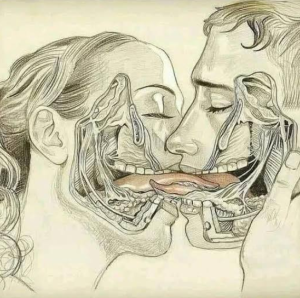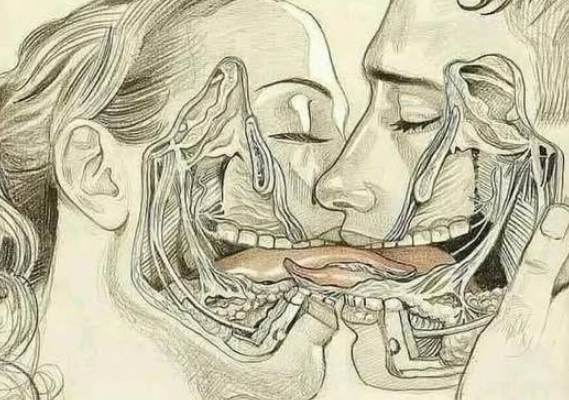Tongue Kissing: The Chemistry of Intimacy and the Language of Connection
A tongue kiss — often called a French kiss — is never just about touching lips. It’s a moment of vulnerability, a sensory exchange, and a silent conversation between two people. It’s playful, passionate, and deeply personal. But beneath the surface of this seemingly simple act lies a complex web of biology, psychology, and emotion. When we tongue kiss, our bodies and minds ignite in ways that are both primal and profound.
💋 The Anatomy of a Kiss
Let’s start with the physical. The human mouth is one of the body’s most sensitive regions, packed with nerve endings that respond to even the lightest touch. The tongue, in particular, is a muscular marvel — agile, expressive, and intimately tied to pleasure pathways in the brain. During a tongue kiss, these nerve endings send signals to the brain’s reward centers, triggering a cascade of neurotransmitters: dopamine (pleasure), oxytocin (bonding), and serotonin (well-being).
Your heart rate increases. Breathing quickens. Pupils dilate. The body becomes more alert, more engaged. It’s a full-body experience, even if only the lips and tongue are involved.
🧠 The Brain on Kissing
Neurologically, kissing is a symphony. The brain lights up in areas associated with memory, emotion, and attachment. That’s why a kiss can feel unforgettable — it’s not just the sensation, but the emotional imprint it leaves behind.
Oxytocin, often called the “love hormone,” plays a starring role. It fosters trust, comfort, and closeness. In long-term relationships, a tongue kiss can be a quiet way of saying “I’m still here” or “we still have this.” It’s a reaffirmation of connection, a reminder of shared intimacy.
🦠 The Microbial Exchange
Here’s a surprising fact: during a 10-second passionate kiss, up to 80 million bacteria can be exchanged. Most of these are harmless, part of the normal oral microbiome. But this microbial mingling isn’t just gross trivia — it’s a subtle form of immune system training. By sharing saliva, partners expose each other to new bacteria, potentially strengthening their immune defenses.
It’s a biological handshake, a microscopic mingling that reflects the larger emotional exchange happening above the surface.
💬 The Language of the Tongue
Tongue kissing is a form of communication. It says things words can’t. “I want you.” “I trust you.” “I’m opening myself to you.” The rhythm, pressure, and responsiveness of a kiss convey desire, affection, and compatibility. It’s a way to test chemistry — not just physical, but emotional.
Some kisses are slow and tender, others wild and urgent. The best ones are attuned to mutual energy, adapting in real time to the partner’s cues. That’s why kissing can feel like dancing — a shared rhythm, a silent choreography.
❤️ Emotional Resonance
Beyond the physical and neurological, tongue kissing carries emotional weight. It’s often the first intimate act in a romantic relationship, a gateway to deeper connection. It can be thrilling, comforting, or even healing.
In moments of stress or sadness, a kiss can offer reassurance. In moments of passion, it can spark desire. And in moments of doubt, it can remind us of what we share.
That’s why kissing is often more memorable than sex. It’s not just about arousal — it’s about meaning.
🧪 The Science of Compatibility
Interestingly, kissing may also play a role in mate selection. Some researchers believe that saliva contains chemical cues about genetic compatibility. Through taste and scent, we may subconsciously assess a partner’s immune system — favoring those whose genes complement our own.
It’s evolutionary matchmaking, hidden in a kiss.
🧍♂️🧍♀️ Vulnerability and Power
Tongue kissing requires vulnerability. You’re close, exposed, and emotionally engaged. That’s why it can feel so intense — and why rejection in that moment can sting so deeply.
But it’s also an act of power. To kiss someone is to assert desire, to claim connection. It’s a mutual surrender, a shared risk. And when it works, it’s electric.
🧵 Cultural Layers
Different cultures view kissing differently. In some places, public kissing is taboo. In others, it’s a casual greeting. But tongue kissing is almost universally reserved for romantic or sexual relationships. It’s intimate, private, and emotionally charged.
That’s why it features so prominently in film, literature, and art. A kiss can symbolize longing, betrayal, reunion, or farewell. It’s a narrative device — and a deeply human ritual.
🧘♀️ Mindfulness in a Kiss
In our fast-paced world, kissing offers a moment of presence. You’re not thinking about your phone, your schedule, or your worries. You’re here — with someone — sharing breath, sensation, and emotion.
It’s a form of mindfulness. A way to ground yourself in connection.
🧭 The First Kiss and the Last
We remember our first kiss. And sometimes, we remember our last. These moments bookend relationships, marking beginnings and endings. They carry emotional echoes — of hope, of loss, of transformation.
A tongue kiss can be a promise. Or a goodbye. Or a spark that reignites something long dormant.
💬 Final Reflection: The Kiss That Speaks Without Words
Tongue kissing is more than a physical act. It’s a language. A ritual. A mirror. It reflects who we are, what we feel, and how we connect. It’s messy, beautiful, and deeply human.
So the next time you kiss — really kiss — remember: your body is speaking. Your brain is listening. And your heart is wide open.

